Increasing Importance of Biomed Techs in a Changing Dialysis World
Download (.zip)
Presented by Vern Taaffe as the lead segment of a panel session at the 2010 NANT Symposium in Las Vegas, Nevada.
Good morning, everyone. Thank you for attending this panel session.
In presenting this session for you, it is an honor, a privilege, and a pleasure to work with Mr. George Rovegno and Drs. Maltais and Ward. All are well-regarded colleagues and long-time friends.
In this session, a panel approach will be used to convey our perspective and predictions on some of the more significant technical aspects of dialysis.
Objectives for the overall panel session are:
1) to explore the increasing importance of biomed techs in a changing dialysis world;
2) to examine equipment disinfection, in regard to rhetoric, reality and the future;
3) to identify the current and future significance of electronic medical records in dialysis; and
4) to determine whether or not carbon is the only answer as an element of water pre-treatment.
Let’s get started by taking a look at the increasing importance of biomed techs in a changing dialysis world.
Good morning, everyone. Thank you for attending this panel session.
In presenting this session for you, it is an honor, a privilege, and a pleasure to work with Mr. George Rovegno and Drs. Maltais and Ward. All are well-regarded colleagues and long-time friends.
In this session, a panel approach will be used to convey our perspective and predictions on some of the more significant technical aspects of dialysis.
Objectives for the overall panel session are:
1) to explore the increasing importance of biomed techs in a changing dialysis world;
2) to examine equipment disinfection, in regard to rhetoric, reality and the future;
3) to identify the current and future significance of electronic medical records in dialysis; and
4) to determine whether or not carbon is the only answer as an element of water pre-treatment.
Let’s get started by taking a look at the increasing importance of biomed techs in a changing dialysis world.
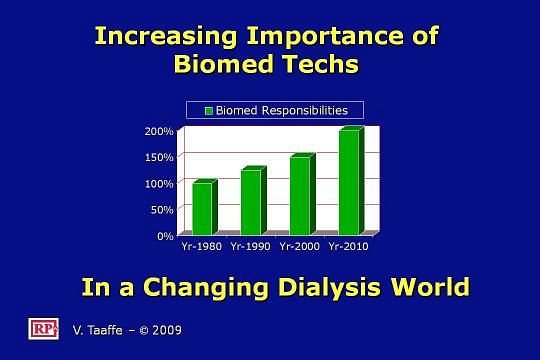
Because this segment of the panel session is somewhat subjective, and I am used to presenting on specific and defined technical issues, it made sense to ask for input from multiple individuals each having 25 or more years of dialysis biomed experience.
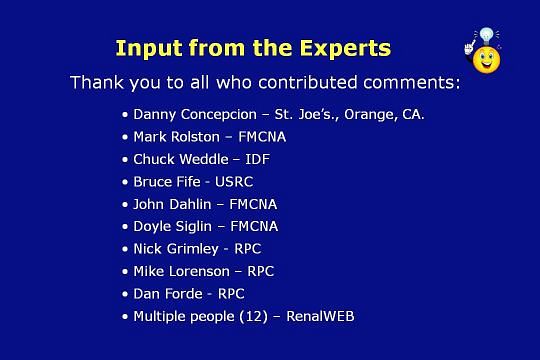
Comments from the persons listed on this slide were very helpful toward providing the broadest possible perspective relevant to the increasing importance of dialysis biomed techs.
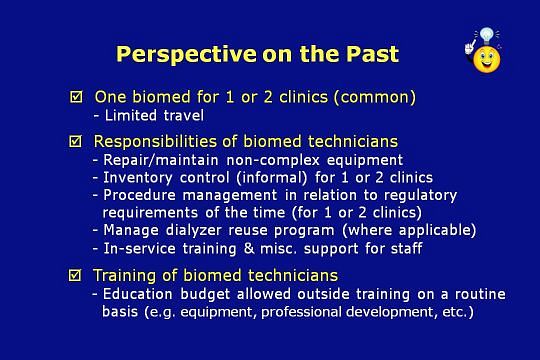
A generation ago, it was typical and routine to have one biomed tech service one or two clinics. Limited travel was the standard. Many hospital-based dialysis clinics existed at the time. Some hospital biomed techs serviced other medical departments in addition to dialysis. Responsibilities of biomed technicians included, but were not limited to the following:
Repair and maintenance of equipment having uncomplicated hydraulic and electronic components.
Inventory control for one or two clinics ... and informal management of the parts stock was common.
Procedure management in relation to regulatory requirements of the time.
Management or supervision of a one- or two-clinic dialyzer reuse program (where applicable).
In-service training & miscellaneous support for staff in one or two clinics.
With regard to training of biomed technicians:
On a routine basis, education budgets of the time typically allowed outside training on equipment, professional development, and other educational areas.
From the past to the present, several factors have had an impact on the biomed position, the key factors of which are outlined on the next four slides.
Repair and maintenance of equipment having uncomplicated hydraulic and electronic components.
Inventory control for one or two clinics ... and informal management of the parts stock was common.
Procedure management in relation to regulatory requirements of the time.
Management or supervision of a one- or two-clinic dialyzer reuse program (where applicable).
In-service training & miscellaneous support for staff in one or two clinics.
With regard to training of biomed technicians:
On a routine basis, education budgets of the time typically allowed outside training on equipment, professional development, and other educational areas.
From the past to the present, several factors have had an impact on the biomed position, the key factors of which are outlined on the next four slides.
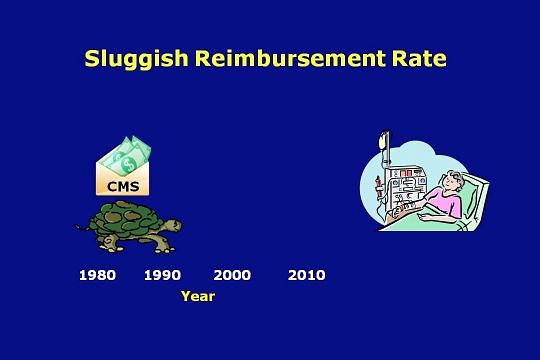
In real dollars, the outpatient dialysis reimbursement rate has fallen over time.
Steadily increasing costs to Medicare for the ESRD program have resulted in attempts at cost-containment by the Centers for Medicare and Medicaid Services through lack of adjustment for inflation in payments for dialysis care. This has resulted in diminished reimbursement in actual dollars when adjusted for inflation.
Dialysis providers have tried various tactics to remain financially solvent. Some of these tactics include: obtaining lower equipment and supply costs from competition in the product marketplace; dialyzer reuse; achieving unit operational efficiencies; and changing staff size. Increased revenues from injectable medications that are administered at the time of dialysis have also helped.
Steadily increasing costs to Medicare for the ESRD program have resulted in attempts at cost-containment by the Centers for Medicare and Medicaid Services through lack of adjustment for inflation in payments for dialysis care. This has resulted in diminished reimbursement in actual dollars when adjusted for inflation.
Dialysis providers have tried various tactics to remain financially solvent. Some of these tactics include: obtaining lower equipment and supply costs from competition in the product marketplace; dialyzer reuse; achieving unit operational efficiencies; and changing staff size. Increased revenues from injectable medications that are administered at the time of dialysis have also helped.
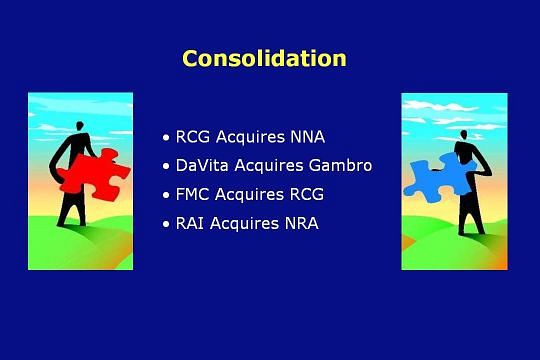
Predictably, the sluggish reimbursement rate has contributed to rapid consolidation in the dialysis industry.
In the past decade, the landscape of the dialysis industry has evolved rapidly as a result of the explosive growth and consolidation in the for-profit sector. In addition, there has been a corresponding contraction of market share for independent units.
Potent business and financial advantages that accrue as a result of consolidation in a market-based system include: volume-based cost efficiencies; technical efficiencies; improved information and tracking systems; access to affordable capital; vertical integration of service and product; the ability to offer attractive one-partner solutions to payers; ... and other significant benefits. Consolidation allows dialysis providers to maintain profit margins in the face of declining constant dollar reimbursement.
According to the Medicare Payment Advisory Commission, in 2007 the Medicare profit margin for all dialysis facilities was 4.9 percent. However, the disparity between the two largest treatment providers and everyone else is significant. The two largest providers had a margin of 6.9 percent, while other freestanding providers had a margin of just 0.2 percent. This difference in margins clearly illustrates the economic benefit of consolidation.
In the past decade, the landscape of the dialysis industry has evolved rapidly as a result of the explosive growth and consolidation in the for-profit sector. In addition, there has been a corresponding contraction of market share for independent units.
Potent business and financial advantages that accrue as a result of consolidation in a market-based system include: volume-based cost efficiencies; technical efficiencies; improved information and tracking systems; access to affordable capital; vertical integration of service and product; the ability to offer attractive one-partner solutions to payers; ... and other significant benefits. Consolidation allows dialysis providers to maintain profit margins in the face of declining constant dollar reimbursement.
According to the Medicare Payment Advisory Commission, in 2007 the Medicare profit margin for all dialysis facilities was 4.9 percent. However, the disparity between the two largest treatment providers and everyone else is significant. The two largest providers had a margin of 6.9 percent, while other freestanding providers had a margin of just 0.2 percent. This difference in margins clearly illustrates the economic benefit of consolidation.
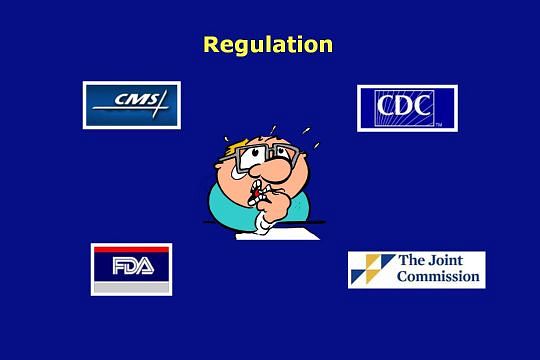
Over the years, the amount and complexity of regulation for dialysis providers has increased dramatically. The latest CMS Conditions for Coverage are much more demanding in that they contain many more tag items when compared with prior CMS requirements. Many of these tag items influence, how, when, and by whom maintenance, repair, and testing will be performed and documented.
In addition, by reference, the Conditions for Coverage now require compliance with certain CDC and FDA provisions ... such as CDC infection control guidelines and the use of devices that are FDA 510k cleared. All of this has made our biomed tech, shown on the slide, a little dizzy trying to keep up with the regulatory requirements and subsequent procedural changes.
In addition, by reference, the Conditions for Coverage now require compliance with certain CDC and FDA provisions ... such as CDC infection control guidelines and the use of devices that are FDA 510k cleared. All of this has made our biomed tech, shown on the slide, a little dizzy trying to keep up with the regulatory requirements and subsequent procedural changes.
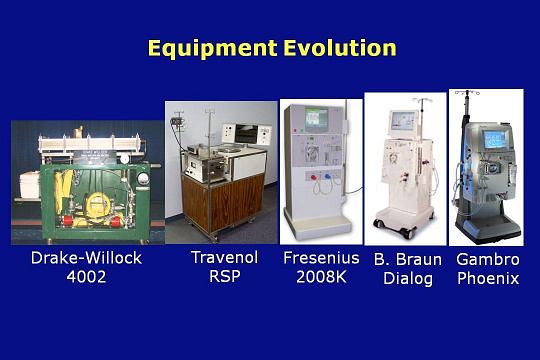
The last, but certainly not the least significant, key factor considered here ... is equipment evolution.
Early dialysis equipment included dialysis machines like the Drake-Willock 4002 and the Travenol RSP. Central dialysate delivery systems and uncomplicated DI water systems were also popular. Repair and maintenance of these type of machines mainly involved work on straightforward hydraulic systems and making calibrations on electronic circuit boards having trim pots for adjustments.
The dialysis equipment of today includes dialysis machines like the Fresenius 2008K, the Braun Dialog, and the Gambro Phoenix. In addition, water systems are now almost exclusively RO based. Repair and maintenance of all these sophisticated machines involves work with complex hydraulic systems that are controlled by computerized electronics operated by and adjusted through the use of software.
Early dialysis equipment included dialysis machines like the Drake-Willock 4002 and the Travenol RSP. Central dialysate delivery systems and uncomplicated DI water systems were also popular. Repair and maintenance of these type of machines mainly involved work on straightforward hydraulic systems and making calibrations on electronic circuit boards having trim pots for adjustments.
The dialysis equipment of today includes dialysis machines like the Fresenius 2008K, the Braun Dialog, and the Gambro Phoenix. In addition, water systems are now almost exclusively RO based. Repair and maintenance of all these sophisticated machines involves work with complex hydraulic systems that are controlled by computerized electronics operated by and adjusted through the use of software.

Okay. Let’s take a look at the present situation.
In the dialysis world of today, it is typical and routine to have one biomed tech service multiple clinics. Considerable travel has become the standard and there are now far fewer hospital based dialysis clinics. Responsibilities of biomed technicians now include, but are not limited to:
• Repair & maintenance of complex equipment, much of which is software-driven.
• Inventory control for multiple clinics ... and formal management of the parts stock is now common.
• Procedure management in relation to greatly increased regulatory requirements.
• Management or supervision of dialyzer reuse programs in multiple clinics (where applicable).
• Providing in-service training and miscellaneous support for staff in multiple clinics.
With regard to training of biomed technicians:
Many, perhaps most, education budgets now emphasize receiving training from within the dialysis provider organization.
In the dialysis world of today, it is typical and routine to have one biomed tech service multiple clinics. Considerable travel has become the standard and there are now far fewer hospital based dialysis clinics. Responsibilities of biomed technicians now include, but are not limited to:
• Repair & maintenance of complex equipment, much of which is software-driven.
• Inventory control for multiple clinics ... and formal management of the parts stock is now common.
• Procedure management in relation to greatly increased regulatory requirements.
• Management or supervision of dialyzer reuse programs in multiple clinics (where applicable).
• Providing in-service training and miscellaneous support for staff in multiple clinics.
With regard to training of biomed technicians:
Many, perhaps most, education budgets now emphasize receiving training from within the dialysis provider organization.
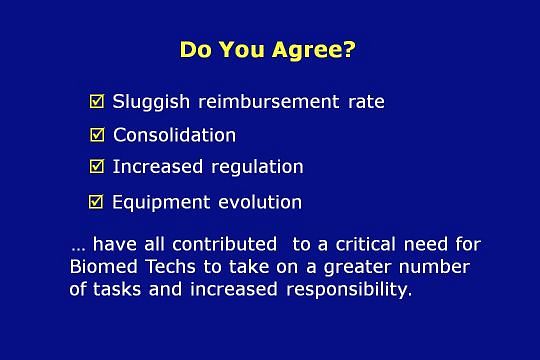
Considering this assessment of the present compared with the past, do you agree that a sluggish reimbursement rate, consolidation, increased regulation, and equipment evolution, have all contributed to a critical need for biomed technicians to take on a greater number of tasks and increased responsibility?
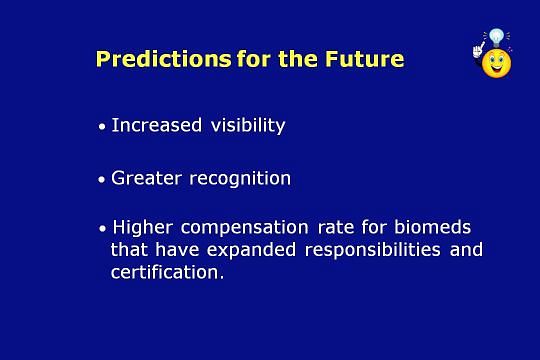
Now that we have reflected on the past and considered the present, what about the future for dialysis biomed technicians?
In December of 2009, the U.S. Department of Labor published the 2010-2011 edition of their Occupational Outlook Handbook. This handbook offers salary projections, employment projections, and general information on numerous careers. For the first time, biomed techs have been placed in their own category as medical equipment repairers. Previously, medical equipment repair was grouped in the same category with other repair professions such as watch, camera, and musical instrument repair. Because it will increase visibility for the profession and it demonstrates that government leaders are now acknowledging the importance of biomed technicians, this change is of great significance for all biomed technicians.
Patient safety will be increasingly tied to quality assurance associated with: complex regulatory compliance; proper maintenance of sophisticated equipment including water systems; and effective control of micro-organisms. Payment from CMS, and clinic certification, cannot continue without passing ESRD audits in these important biomed areas.
As this understanding prevails, there will be greater recognition for dialysis biomed technicians and a higher compensation rate for biomeds who have expanded responsibilities and certification.
In December of 2009, the U.S. Department of Labor published the 2010-2011 edition of their Occupational Outlook Handbook. This handbook offers salary projections, employment projections, and general information on numerous careers. For the first time, biomed techs have been placed in their own category as medical equipment repairers. Previously, medical equipment repair was grouped in the same category with other repair professions such as watch, camera, and musical instrument repair. Because it will increase visibility for the profession and it demonstrates that government leaders are now acknowledging the importance of biomed technicians, this change is of great significance for all biomed technicians.
Patient safety will be increasingly tied to quality assurance associated with: complex regulatory compliance; proper maintenance of sophisticated equipment including water systems; and effective control of micro-organisms. Payment from CMS, and clinic certification, cannot continue without passing ESRD audits in these important biomed areas.
As this understanding prevails, there will be greater recognition for dialysis biomed technicians and a higher compensation rate for biomeds who have expanded responsibilities and certification.
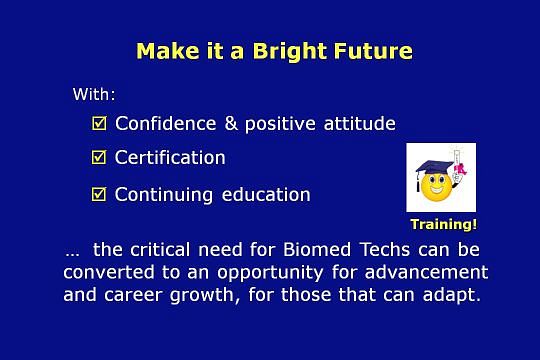
To close this part of the panel session, the points made here make it clear that, with confidence and a positive attitude, certification and continuing education (which includes improvement of communication skills and learning about capital equipment planning), the critical need for dialysis biomed techs can be converted into an opportunity for advancement and rewarding career growth for those who can adapt.
Regarding certification, the NNCO Certified Biomedical Nephrology Technician exam is being updated at this meeting and the revised exam should be available in the near future.
Thank you.
Regarding certification, the NNCO Certified Biomedical Nephrology Technician exam is being updated at this meeting and the revised exam should be available in the near future.
Thank you.
